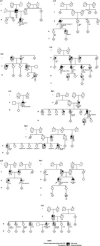AXIN2 germline testing in a French cohort validates pathogenic variants as a rare cause of predisposition to colorectal polyposis and cancer
- PMID: 36502525
- PMCID: PMC10107344
- DOI: 10.1002/gcc.23112
AXIN2 germline testing in a French cohort validates pathogenic variants as a rare cause of predisposition to colorectal polyposis and cancer
Abstract
Only a few patients with germline AXIN2 variants and colorectal adenomatous polyposis or cancer have been described, raising questions about the actual contribution of this gene to colorectal cancer (CRC) susceptibility. To assess the clinical relevance for AXIN2 testing in patients suspected of genetic predisposition to CRC, we collected clinical and molecular data from the French Oncogenetics laboratories analyzing AXIN2 in this context. Between 2004 and June 2020, 10 different pathogenic/likely pathogenic AXIN2 variants were identified in 11 unrelated individuals. Eight variants were from a consecutive series of 3322 patients, which represents a frequency of 0.24%. However, loss-of-function AXIN2 variants were strongly associated with genetic predisposition to CRC as compared with controls (odds ratio: 11.89, 95% confidence interval: 5.103-28.93). Most of the variants were predicted to produce an AXIN2 protein devoid of the SMAD3-binding and DIX domains, but preserving the β-catenin-binding domain. Ninety-one percent of the AXIN2 variant carriers who underwent colonoscopy had adenomatous polyposis. Forty percent of the variant carriers developed colorectal or/and other digestive cancer. Multiple tooth agenesis was present in at least 60% of them. Our report provides further evidence for a role of AXIN2 in CRC susceptibility, arguing for AXIN2 testing in patients with colorectal adenomatous polyposis or cancer.
Keywords: Wnt signaling pathway; adenomatous polyposis; colorectal cancer susceptibility; oligodontia.
© 2022 The Authors. Genes, Chromosomes and Cancer published by Wiley Periodicals LLC.
Conflict of interest statement
The authors declare no conflict of interest.
Figures




References
-
- Stoffel EM, Boland CR. Genetics and genetic testing in hereditary colorectal cancer. Gastroenterology. 2015;149(5):1191‐1203.e2. - PubMed
-
- Behrens J, Jerchow BA, Würtele M, et al. Functional interaction of an axin homolog, conductin, with beta‐catenin, APC, and GSK3β. Science. 1998;280(5363):596‐599. - PubMed
-
- Mai M, Qian C, Yokomizo A, Smith DI, Liu W. Cloning of the human homolog of conductin (AXIN2), a gene mapping to chromosome 17q23‐q24. Genomics. 1999;55(3):341‐344. - PubMed
MeSH terms
Substances
LinkOut - more resources
Full Text Sources
Medical

